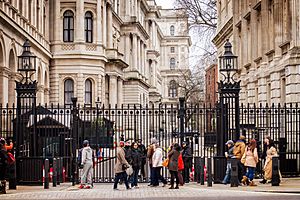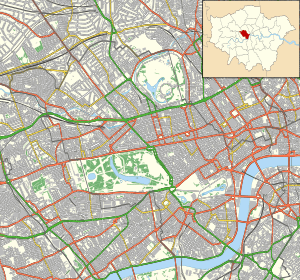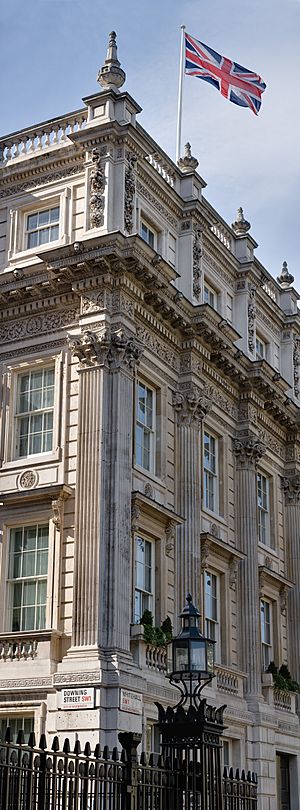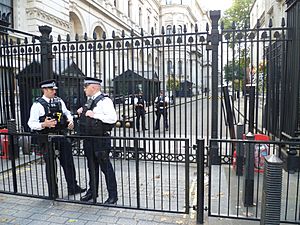Downing Street facts for kids

Downing Street as captured from Whitehall, 2013
|
|
| Namesake | Sir George Downing, 1st Baronet |
|---|---|
| Owner | UK Government |
| Length | 217 m (712 ft) |
| Postal code | SW1A |
| Coordinates | 51°30′12″N 0°07′39″W / 51.5034°N 0.1276°W |
| From | Whitehall |
| Construction | |
| Completion | 1680 |
| Other | |
| Known for | Official residences and offices of the Prime Minister of the United Kingdom and the Chancellor of the Exchequer |
| Status | Closed to public |
Downing Street is a street in London, England. It is about 200 meters (656 feet) long. This famous street is home to the official offices and homes of the Prime Minister of the United Kingdom and the Chancellor of the Exchequer. The Prime Minister is the head of the UK government. The Chancellor of the Exchequer is in charge of the country's money.
Downing Street is located near Whitehall. It is also just a short walk from the Houses of Parliament. The street was built in the 1680s by an Irishman named Sir George Downing, 1st Baronet.
For over 300 years, Downing Street has been important. It has housed the main leaders of the UK government. The Prime Minister's official home is 10 Downing Street. The Chancellor's official home is Number 11. The government's Chief Whip also has an official home at Number 12. Sometimes, these leaders might live in different houses on the street. For example, the current Chief Whip lives at Number 9.
The name "Downing Street" is often used to mean the Prime Minister or the UK Government itself.
Contents
History of Downing Street

Downing Street was built between 1682 and 1684. It was created by Sir George Downing, 1st Baronet. He built it on the site of an old mansion called Hampden House. Before that, there might have been a brewhouse there.
Sir George Downing was a soldier and a diplomat. He worked for both Oliver Cromwell and King Charles II. He was very good at buying properties and became very rich. In 1654, he bought land near St James's Park. This land was close to the Houses of Parliament. Downing wanted to build many nice houses for important people.
He got permission to build more houses in 1682. The new houses were built as a cul-de-sac. This means it was a street with only one entrance. It had two-story houses with places for coaches and horses. The houses also had nice views of St James's Park.
Historians are not sure how many houses Downing built. Some say 15, others say 20. The house numbers changed over time. For example, Number 10 was once Number 5. It was renumbered in 1787. Sir Christopher Wren, a famous architect, helped design the houses. They were built quickly and cheaply. The fronts of the houses were painted to look like brick. Winston Churchill once said that Number 10 was "shaky and lightly built."
The street was quiet and private because it was a cul-de-sac. An advertisement in 1720 called it "a pretty open Place." It said the houses were "fit for Persons of Honour and Quality." Many important people lived there. The Countess of Yarmouth lived at Number 10 from 1688 to 1689. Lord Lansdowne lived there from 1692 to 1696. The Earl of Grantham lived there from 1699 to 1703.
Sir George Downing probably never lived in his houses. He retired to Cambridge in 1675 and died shortly after the houses were finished. His picture hangs in the entrance of the modern Number 10.
The Downing family also helped start Downing College, Cambridge. This college was founded in 1800. A door from Number 10 is even used at the college.
Some houses on Downing Street were later taken down. In 1824, houses between Number 10 and Whitehall were removed. This made space for new government offices. In 1861, houses on the south side of the street were replaced. New offices were built for the Foreign Office and other government departments.
Important Houses on Downing Street
- 1-8 Downing Street were houses that were taken down in 1824. This made room for new government buildings.
- 9 Downing Street is now where the Downing Street Press Briefing Room is located. This is where government announcements are made.
- 10 Downing Street is the official home of the Prime Minister of the United Kingdom. The Prime Minister is also known as the First Lord of the Treasury. This house has been the Prime Minister's home since 1735. It was originally three houses. Number 10 has about 100 rooms. The Prime Minister's family lives on the third floor. There is a kitchen in the basement. Other floors have offices and meeting rooms. Here, the Prime Minister works and meets with other leaders. Behind the house is a courtyard and a garden. Other people who live or work at Number 10 include the Prime Minister's family and the Chief Mouser to the Cabinet Office (a cat!).
- 11 Downing Street has been the official home of the Chancellor of the Exchequer since 1828. The Chancellor is also called the Second Lord of the Treasury. This house was built in 1682, at the same time as Number 10.
- 12 Downing Street used to be the Chief Whip's office. Now, it holds the Prime Minister's Press Office. It also has units for communications and research. This building was damaged by fire in 1879 and has changed over time.
- 13 Downing Street was once part of Number 12. It was re-built and re-numbered in 1876.
- 14 Downing Street used to be at the end of the street. It was a private house for many years. It was bought by the Crown in 1798. It was used by government offices in the 1800s. Parts of it were taken down in the 1860s, and it was completely removed by 1876.
- 15–20 Downing Street were houses that are now gone. They led towards Horse Guards Road. These houses were also used by different government offices.
There used to be a pub called the Rose and Crown on Downing Street.
Sometimes, ministers have swapped homes on Downing Street. For example, after the 1997 election, Tony Blair became Prime Minister. He had a family with three children. Gordon Brown became Chancellor and was unmarried. So, Blair and his family moved into the larger Number 11. Brown lived in the smaller apartments of Number 10. This arrangement has happened with other leaders too. David Cameron and Theresa May also lived in Number 11 when they were Prime Minister.
Security Gates
Security barriers were first put up at the end of Downing Street in 1920. This was for a public event to control crowds.
Later, during the Irish War of Independence, violence increased. So, the barriers were made stronger. In November 1920, an 8-foot-high wooden barricade was built. It had strong foundations and vehicle gates. These barriers were removed in 1922 when the Irish Free State was formed.
In 1973, metal barriers were placed at the street's entrance. In 1974, the police suggested more barriers. They wanted to keep people off the main part of the street. But the Prime Minister, Harold Wilson, said no. He felt it would limit public freedom too much.
In 1982, access was restricted even more with railings and a gate. These were replaced by black steel gates in 1989. Security was increased because of more violence, especially from the IRA. The government decided to increase security after Lord Mountbatten was killed in 1979.
Public Access
Even with the gates, Downing Street is still legally a public road. However, police use special powers to control who can enter. Only scheduled visitors, people with special passes, and accredited journalists are allowed in.
Current Security
Since 1989, you must pass through a security checkpoint to enter Downing Street. The street is patrolled by armed police officers. There is usually at least one police officer outside the front door of Number 10. Security was made even tighter after 10 Downing Street was attacked with a mortar bomb by the IRA in 1991.
See also
 In Spanish: Downing Street para niños
In Spanish: Downing Street para niños
- Downing Street Christmas Tree
- List of eponymous roads in London
Images for kids






